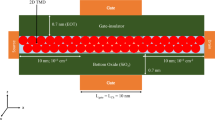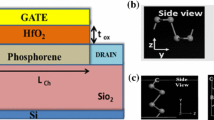Abstract
In this paper, we propose a new ohmic-structure of ballistic carbon nanotube field-effect transistors (CNTFETs) in which the source and drain regions are doped stepwise and the device acts as MOSFET like CNTFET (MOSCNT). The number of lightly doped regions and their doping concentrations are optimized to obtain the lowest OFF current. To study the device characteristics, the Poisson–Schrödinger equations are solved self-consistently using the Nonequilibrium Green’s Function (NEGF) formalism in the mode space approach. To find the Hamiltonian matrix, the tight-binding approximation with only p z orbital is used. The obtained results show that the stepwise regions lead to barrier widening due to the reduction in potential gradient. Therefore, the band-to-band tunneling (BTBT) and the ambipolar behavior of the device decrease due to band engineering. This causes to the superior reduction of OFF current and dissipative power. In addition, the device performance shows lower subthreshold swing (SS), smaller drain induced barrier lowering (DIBL), and larger current ratio than that of the previous structures.









Similar content being viewed by others
References
P. Avouris, Molecular electronics with carbon nanotubes. Acc. Chem. Res. 35(12), 1026–1034 (2002)
J. Guo, M.S. Lundstrom, Role of phonon scattering in carbon nanotube field-effect transistors. Appl. Phys. Lett. 86 (2005)
M.S. Fuhrer, M. Forero, A. Zettl, P.L. McEuen, Ballistic transport in semiconducting carbon nanotubes, in AIP Conference Proceedings, in Electronic Properties of Molecular Nanostructures (2001), pp. 401–404 (link to paper on AIP website)
J. Guo, S. Datta, M.S. Lundstrom, A numerical study of scaling issues for Schottky-Barrier carbon nanotube transistors. IEEE Trans. Electron Devices 51(2), 172–177 (2004)
Y.M. Lin, J. Appenzeller, J. Knoch, P. Avouris, High-performance carbon nanotube field-effect transistor with tunable polarities. IEEE Trans. Nanotechnol. 4(5), 481–489 (2005)
E.J. Nowak, Maintaining the benefits of CMOS scaling when scaling bogs down. IBM J. Res. Dev. 46(2), 169–180 (2002)
J. Guo, M. Lundstrom, Device simulation of SWNT-FETs, in Carbon Nanotube Electronics (Springer, New York, 2009), pp. 107–132, Chap. 5
O. Siyuranga, S. Koswatta, D. Nikonov, M.S. Lundstrom, Computational study of carbon nanotube p-i-n tunnel FETs, in IEEE Int Electron Dev. Meet (2005), pp. 518–521
I. Hassaninia, M.H. Sheikhi, Z. Kordrostami, Simulation of carbon nanotube FETs with linear doping profile near the source and drain contacts. Solid-State Electron. 52, 980–985 (2008)
S. Heinze, J. Tersoff, P. Avouris, Electrostatic engineering of nanotube transistors for improved performance. Appl. Phys. Lett. 83(24), 5038–5040 (2003)
R. Yousefi, K. Saghafi, M.K. Moravvej-Farshi, Numerical study of lightly doped drain and source carbon nanotube field-effect transistors. IEEE Trans. Electron Devices 57(4), 765–771 (2010)
Z. Ren, ‘Nanoscale MOSFETs: physics, simulation, and design. Ph.D. thesis, the Purdue University, USA, 2001
J. Guo, Carbon nanotube electronics: modeling, physics and applications. Ph.D. thesis, the Purdue University, USA, 2004
Y. Li et al., Preferential growth of semiconducting single-walled carbon nanotubes by a plasma enhanced CVD method. Nano Lett. 4(2), 317–321 (2004)
J. Guo, S. Datta, M. Lundstrom, M.P. Anantram, Toward multiscale modeling of carbon nanotube transistors. Int. J. Multiscale Comput. Eng. 2(2), 257–277 (2004)
S.O. Koswatta, M.S. Lundstrom, M.P. Anantram, D.E. Nikonov, Simulation of phonon-assisted band-to-band tunneling in carbon nanotube field-effect transistors. Appl. Phys. Lett. 87, 253107 (2005)
International Technology Roadmap for Semiconductors (ITRS) (2009), http://www.itrs.net/Links/2009ITRS/Home2009.htm
J. Knoch, S. Mant, J. Appenzeller, Comparison of transport properties in carbon nanotube field-effect transistors with Schottky contacts and doped source/drain contacts. Solid-State Electron. 49, 73 (2005)
J. Appenzeller, Yu-Ming Lin, J. Knoch, Z. Chen, Ph. Avouris, Comparing carbon nanotube transistors—the ideal choice: a novel tunneling device design. IEEE Trans. Electron Devices 52, 2568 (2005)
S.O. Koswatta, S. Hasan, M.S. Lundstrom, M.P. Anantram, D.E. Nikonov, Nonequilibrium Green’s function treatment of phonon scattering in carbon-nanotube transistors. IEEE Trans. Electron Devices 54(9), 2339–2351 (2007)
K. Boucart, A.M. Ionescu, Double-gate tunnel FET with high-K gate dielectric. IEEE Trans. Electron. Dev. 54(7) (2007)
H. Zhou, M. Zhang, Y. Hao, Performance optimization of MOS-like carbon nanotube-FETs based on electrostatic doping. J. Comput. Electron. 9, 87–92 (2010)
J. Guo, A. Javey, H. Dai, M. Lundstrom, Performance analysis and design optimization of near ballistic carbon nanotube field-effect transistor, in IEEE Int. Meet. Electron. Dev., IEDM (2004)
Z. Chen, J. Appenzeller, J. Knoch, Yu-Ming Lin, Ph. Avouris, The role of metal-nanotube contact in the performance of carbon nanotube field-effect transistors. Nano Lett. 5, 1497 (2005)
Author information
Authors and Affiliations
Corresponding author
Rights and permissions
About this article
Cite this article
Moghadam, N., Aziziyan, M.R. & Fathi, D. Design and simulation of double-lightly doped MOSCNT using non-equilibrium Green’s function. Appl. Phys. A 108, 551–557 (2012). https://doi.org/10.1007/s00339-012-6926-2
Received:
Accepted:
Published:
Issue Date:
DOI: https://doi.org/10.1007/s00339-012-6926-2




